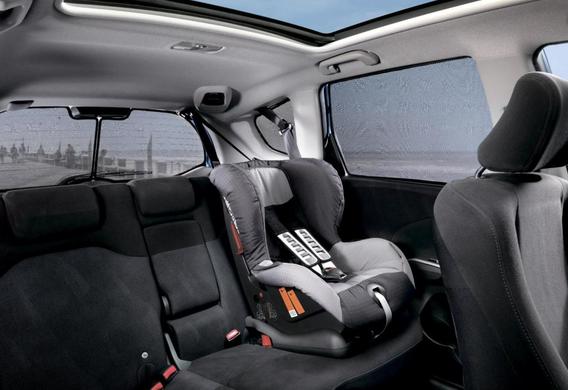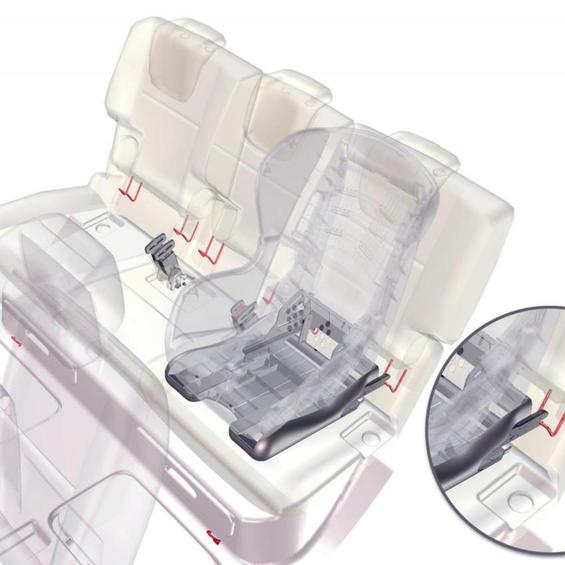
At first glance, this question may seem rhetorical. There's a special children's seat-it's enough to put a child in it, and he'll be safe here. It turns out that this is far from all aspects of child safety. First of all, not every driver knows how this chair is properly installed. Second, not all children can be forced to sit in it. Third, the chair itself is not a panacea. In most cases, the safety of the child depends primarily on adult literacy.
The child, of course, is not a smaller copy of the adult.
The bone tissue of children has a fibrous structure, a low concentration of mineral salts and a large amount of water. Accordingly, the bones of the child are more fragile. So, if a child gets a severe head injury, this injury will be much more serious than that of an adult, because it is likely to hit the brain.
There are nuances in the structure of a children's skeleton. If the adult's cervical vertebrae are not only "ossified", but also of gradic form, the child's cervical vertebrae are cartilage, not bone tissue. Therefore, with a strong push, children are more likely to have a fracture of cervical vertebra than adults. After all, the child's head is 25% of the weight of the body (compared to the adult 6%), for this reason, in case of a blow occurring in an accident, the head is "discards" and the entire burden falls on the fragile neckline of the child.
Can the child not be fastening
When the vehicle is stopped rapidly due to the collision, the body of a person not recorded by the safety-belt is moved around the inertia about approximately the speed of the vehicle. The man strikes the interior of the cabin, and in some cases even flies out through the windshield or through the back window, with serious injuries. If the machine turns upside down, the neck is likely to be broken. This is true for both adults and children, but for the reasons stated above, the consequences are more severe for children. Accordingly, the child in the car must be fastened.
Can you fasten your child with a standard seat belt?
To be effective, the belt must be properly secured. Otherwise, it may not be saved, it can be further traumatized by humans.
"Adults" do not fit the child with the size and height, respectively, they cannot be properly fixed. Some parents spend their time at the arm of the child, but under severe braking, such a situation threatens to vexing or fracture, even if the car is at a low speed. Especially dangerous when the belt passes through the child's neck, because there is a possibility of suffocation. It is also possible to prevent the child from slipping under the belt, which is also fraught with suffocation (this option is possible if the strap is loose). It can be concluded from all this that the "adult" time of the child is contraindicated.
Whether the child can be held
In case of a sudden collision, the body of a man starts the movement at the salon at a high speed. However, the weight of the weight is increased. Therefore, in case of impact (even at a small car speed) the weight of the child is increased in times. Even a strong, strong man, not to mention a fragile mother, will not be able to hold him down. In addition, there is a great probability that an adult, leaning forward in the clash, can put a child in his own body. Therefore, this is one of the most dangerous ways to transport children.
Children's car seats
Children's car seats take account of the above features of the child's body, as well as provide a special level of safety for the small passenger. According to statistics, these devices reduce the risk of injury for infants by 71%, for children up to 3 years-by 54%, and for children from 3 to 12 years-by 50%.
There are the following groups of chairs:
- 0 (weight of the child between 0 and 10 kg and age by year);
- 0 + (0-13 kg and 0-1.5 years)
- 1 (9-18 kg and 1 to 4 years),
- 2 (15 -25 kg and 3-7 years),
- 3 (22-36 kg and 7-10 years).
In principle, the figures are very approximate. If you buy a chair, you have to take the baby with you. Before purchase, we need to put the child in a chair and check whether it is comfortable to sit there (whether the head is headless, whether the head is on the head restraint, etc.). It is not recommended to purchase a chair "on the roast", because the safety of the child depends on a properly selected chair.

All car seats are fixed either by a normal seat belt (majority of seats) or by the Isofix system. This system is embedded in a children's chair with handsets at the end and special brackets embedded in the seat of the car. However, not all vehicles have such a system.

However, it is very convenient to install and remove the chair from the car without any special difficulties. Such a system of fastenings for the carriage of breastplate is particularly relevant: it is possible to avoid disturbing the child without disturbing the child and moving it directly into the carcasses. Transport of infants
Transport of infants
It is recommended that the guns be carried in special carts. The child is in the position of lying and being held in a special, soft, wide belt. Such a device shall be installed along the rear seat.
You can also set the group chair to 0 +. It is fixed against movement, back to the windshield. The littleln in this chair is in a position of lying or half-sitting, with three-or five-point-belts retained. This chair group usually has a bridge handle, and expensive modifications can even be transformed into a stroller. In addition, they often take the form of a deep bowl or have a special bar to protect the baby from the blow of the sitting chair.
Children older than 1 year
Before you purchase the chair, you should check if it is suitable for a particular car.
If there is a seat cushion in the front seat, you can't put a children's chair there. Unless there is a function to disable the pillow.
One of the popular means of transportation of children is the children's seat of the boster (booster). It's lifting the baby so that the standard seat belts are properly placed on the baby's body. The Buster is suitable for children between 5 and 12 years (weight must be 15 kg and above).
The child goes to the booster and is fixed (together with the seat) of the staff belt. If the belt is correct, the belt must pass over the child's shoulder.
Some parents use a common pillow instead of a booster. But this is not right. With impact, the normal pillow will simply "fly away" from under the child, and the belt in such a case may change the baby's throat.
Unlike the car seat, the buster is much lighter and compact. This seat also benefits from a simple installation and price. Besides, car thieves are not likely to be at the dawn of him. But according to statistics, the level of buster's safety is lower than the car seat. Buster is the best for short trips. Given this point, many car seats are produced with a transformation function in a booster.
Special provisions for the carriage of children are also used for the normal seatbelt. These draught (adapters) are a dense portion of a cloth that connects two parts of the belt to the abdominal level of the child, rather than the neck level, as is the case with the use of an "adult" belt. That is, the hating helps to "build" a normal seat belt under the child's dimensions. The device is popular, first of all, because of its budget.
Thus, in order to protect the child's child, special child restraints should be used, which are chosen by the size and age of the child. Such devices can be purchased in their own taste and financial possibilities.
Article 22.9 of the Road Traffic Regulations requires that children up to the age of 12 years be carried with child restraint devices (car seats) appropriate to the weight and height of the child, or other means of securing the child's seat belts. And if the fine for this violation was not very high, it is now comparable to the price of a good car seat.







